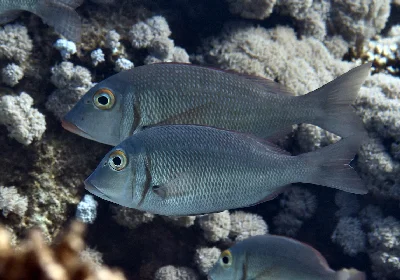Snubnose Emperor
Lethrinus borbonicus
Lethrinus borbonicus, commonly referred to as the snubnose emperor, is a marine ray-finned fish that belongs to the family Lethrinidae, which includes emperor breams and emperors. This species is prevalent in the 🌊 Western Indian Ocean and holds significant value for commercial fisheries within this region.
Achille Valenciennes, a French zoologist, first formally described Lethrinus borbonicus in 1830, with Réunion in the Mascarene Islands noted as its type locality. Although some authors classify the genus Lethrinus within the monotypic subfamily Lethrininae—distinguishing it from other genera traditionally placed in Monotaxinae—the 5th edition of "Fishes of the World" does not acknowledge such subfamily distinctions within Lethrinidae. This family is categorized under the order Spariformes by the aforementioned reference.
The species name 'borbonicus' is derived from 'Borbon' or 'Bourbon', an historical name for Réunion. Lethrinus borbonicus is characterized by a dorsal fin supported by 10 spines—of which the 4th or 5th spine tends to be the longest—and 9 soft rays. Its anal fin features 3 spines and 8 soft rays. The fish exhibits a moderately deep body, with a body depth ratio to its standard length ranging from 2.5 to 2.8 times. Noteworthy morphological features include a convex interocular space, a short, blunt snout with a straight profile, molar-like teeth on the sides of the jaws, and a ridge on the outer surface of the maxilla. Additionally, the axilla of the pectoral fin is fully scaled. The coloration is predominantly dark grey or yellowish with a whitish ventral surface and indistinct dark bars, while the fins display varied tones such as white, pinkish, and reddish with distinct patterns. The species can reach a maximum length of 40 cm, although a more typical length is approximately 25 cm.
Geographically, Lethrinus borbonicus inhabits the 🌊 Western Indian Ocean, extending along the eastern coast of Africa from the Gulf of Suez and the Gulf of Aqaba down to Sodwana Bay in 🇿🇦 South Africa. It is also found around 🇲🇬 Madagascar, the Comoro Islands, the 🇸🇨 Seychelles, the Mascarene Islands, the Arabian Peninsula, and the 🌊 Persian Gulf, reaching as far east as 🇵🇰 Pakistan. This species typically resides at depths ranging from 1 to 40 meters, favoring sandy substrates near coral reefs. During the day, they may form small groups, while at night, they become solitary hunters over reef flats and slopes.
The diet of Lethrinus borbonicus primarily comprises echinoderms, molluscs, and crustaceans. This species exhibits a rapid growth rate and a relatively short lifespan, with spawning occurring from March to June in the southern 🌊 Persian Gulf.
Although Lethrinus borbonicus holds minor significance in commercial fisheries throughout its range, it is of notable commercial value in the 🌊 Persian Gulf. Methods for its capture include fish traps, bycatch in trawl fisheries, and hand lines.
Comments
Please, sign in to leave comment
No Comments yet
Last Update: May 28, 2025

